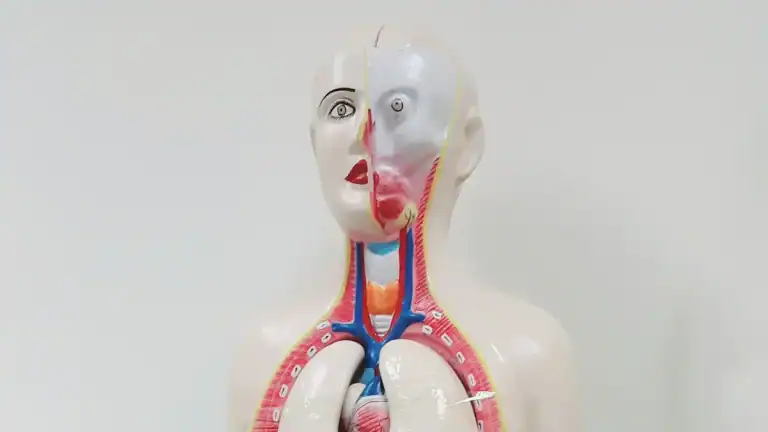Chest pain between breasts in women demands immediate attention. Not all breast pain is serious, but certain chest pain symptoms require urgent evaluation. Heart disease in women often presents differently than in men. You may experience atypical heart symptoms; doctors frequently overlook this disease. This blog helps you recognize urgent causes of chest pain.
You will understand when to seek emergency care for your cardiovascular health. Pay close attention to any unusual pain in your chest. This breast pain, or any breast pain in women, needs prompt medical assessment for any concerning symptoms.
Key Takeaways
Chest pain between breasts in women needs quick attention. Some types of pain are serious and need a doctor right away.
Women’s heart attack signs can be different from men’s. Look for dizziness, sweating, shortness of breath, or back pain, not just chest pain.
If you have sudden, bad chest pain, call 911 right away. Do not try to drive yourself to the hospital.
Not all chest pain is from the heart. Conditions like GERD or muscle strain can also cause it. Still, always get chest pain checked by a doctor.
Urgent Chest Pain Between Breasts
You must understand the urgent causes of chest pain between breasts. These conditions often involve your heart or lungs. Recognizing these signs quickly can save your life.
The most common urgent causes of chest pain between breasts include:
Heart attack: You may feel pressure or discomfort in your chest. This can occur in the center of your chest.
Angina: You experience tightness or squeezing in your chest. This happens when your heart muscle does not get enough blood.
Pulmonary embolism: A blockage forms in your lung blood vessels. This causes pain you can feel under your breastbone.
Pleurisy: The lining of your lung becomes inflamed. This leads to sharp or stabbing chest pain.
Pneumonia: A lung infection can cause sharp or stabbing chest pain. This pain worsens when you breathe deeply or cough.
Women’s Heart Attack Symptoms
A heart attack in women often presents differently than in men. You might not feel the classic crushing chest pain. Your heart attack symptoms can be more subtle. This does not make them less serious. The pain you feel may be less intense. However, it still signals a critical problem with your heart. You need to recognize these signs of heart attack.
Atypical Cardiac Symptoms
Women frequently experience atypical cardiac symptoms during a heart attack. These symptoms can be confusing. They do not always point directly to your heart. Many women experience these unusual signs. Approximately 85% of women show atypical manifestations. These include dizziness, sweating, shortness of breath, vomiting, palpitation, fainting, back pain, and fatigue. Only 70% of men experience these same symptoms.
You might feel:
Dizziness
Sweating
Shortness of breath
Vomiting
Palpitation
Fainting
Back pain
Fatigue
Other common atypical symptoms include:
Shortness of breath
Nausea
Fatigue
Do not ignore these symptoms. They are crucial signs your heart needs immediate attention. Any new or worsening breast pain or chest pain requires evaluation. This is especially true if you feel pain in the center of the chest. Your heart health is vital. This type of pain indicates a serious disease.
Other Urgent Chest Pain Causes
Other urgent causes of chest pain can also affect your chest and heart. These conditions require immediate medical attention. You must recognize their specific signs.
Pulmonary Embolism
A pulmonary embolism occurs when a blood clot blocks an artery in your lungs. This blockage can be life-threatening. You might experience sudden, sharp pain in your chest. This pain often worsens when you breathe deeply or cough. You may also feel short of breath, dizzy, or lightheaded. Sometimes, you might cough up blood. Seek emergency care if you suspect a pulmonary embolism.
Aortic Dissection
Aortic dissection is a serious condition. It happens when the inner layer of your aorta, the body’s main artery, tears. Blood then surges through this tear, splitting the layers of the aorta. This can be fatal if not treated quickly.
You experience sudden, severe pain in your chest or upper back. This pain often feels like tearing or ripping. It can spread to your neck or down your back. You might also notice sudden severe stomach pain. Other symptoms include loss of consciousness, shortness of breath, or sudden vision problems. You could have difficulty speaking, or weakness on one side of your body.
A weak pulse in one arm or thigh compared to the other can also indicate this condition. Doctors often distinguish this pain from a heart attack because of its abrupt onset and maximal severity right away. If you have symptoms suggesting a heart attack but lack classic electrocardiogram findings, doctors might suspect aortic dissection. A blood pressure difference greater than 20 mm Hg between your arms should also raise suspicion.
Heart Inflammation
Your heart can also become inflamed. This condition is called myocarditis or pericarditis. Myocarditis affects the heart muscle, while pericarditis affects the sac surrounding your heart. Both can cause breast pain.
Chest pain is a common symptom for all types of heart inflammation. You might feel a sharp or stabbing breast pain. This pain can worsen when you lie down or breathe deeply. Many factors can cause heart inflammation. Infections are common culprits.
These include viruses like the flu, COVID-19, or herpes. Bacterial infections, such as Lyme disease or rheumatic fever, can also cause it. Autoimmune diseases like rheumatoid arthritis or lupus can lead to heart inflammation. A chest injury or trauma can also be a cause. Exposure to harmful substances, certain medications, or other medical problems like a heart attack or cancer can also trigger it. This type of breast pain needs prompt medical attention.
Urgent vs. Non-Urgent Chest Pain
You must understand the difference between urgent causes of chest pain and less serious ones. Not all discomfort in your chest signals a life-threatening event. However, you should always take chest pain seriously.
Common Non-Cardiac Chest Pain
Not all pain in your chest means a heart problem. Many other conditions cause discomfort between your breasts. These are often non-cardiac causes.
GERD (Gastroesophageal Reflux Disease): This is chronic acid reflux. It is the most common cause of noncardiac chest pain. Gastric acid irritates your esophagus. You feel a burning sensation.
Esophagitis: This is inflammation of your esophagus. GERD often causes it. Infections, medications, or allergies can also lead to it.
Costochondritis: This is inflammation of the cartilage connecting your ribs to your breastbone. You feel sharp pain when you press on your breast area.
Musculoskeletal Pain: Muscle strains or injuries in your chest wall can cause breast pain. This pain often worsens with movement or touch.
When to See a Doctor
You must know when to seek medical help for breast pain. Some symptoms demand immediate attention. Do not ignore these signs.
Seek emergency care if you experience:
Nausea or vomiting.
Shortness of breath.
Light-headedness or fainting.
A rapid or irregular heartbeat.
Pain radiating to your back, jaw, neck, upper abdomen, arm, or shoulder.
Chest pain that is new, comes on suddenly, or lasts longer than five minutes after resting.
Chest discomfort lasting more than 15 minutes.
An increasing pattern of chest pain over time. For example, you feel more discomfort with less activity.
Sudden, severe chest pain. It might feel like a crushing sensation.
Pain that gradually worsens, even if it starts mild.
Any unexplained chest pain that concerns you. Always get it checked. Your heart health is important. Do not try to sort it out yourself if you suspect a heart attack or heart disease.
Immediate Action for Urgent Chest Pain Symptoms

You must act quickly if you experience chest pain that suggests an urgent medical issue. Do not delay. Your prompt response can significantly impact your outcome. Recognizing the sudden onset of symptoms and knowing what to do next is crucial.
Call 911 Immediately
If you suspect a heart attack or any other severe cause of pain in your chest, call 911 immediately. Do not try to drive yourself to the hospital. Emergency medical services (EMS) can provide critical care on the way. Paramedics can perform initial tests, such as an electrocardiogram (ECG), in the ambulance.
This test records your heart’s electrical activity. They can transmit this information to the emergency department. This helps doctors prepare for your arrival and expedite your care. Calling 911 ensures you receive immediate medical attention. You need to seek help without hesitation.
Emergency Response Expectation
When you arrive at the emergency room for chest pain, you can expect a structured process. First, a triage nurse will evaluate you. They prioritize your care based on the severity of your symptoms. Next, a doctor will perform a brief physical examination. They will check your vital signs, including blood pressure and heart rate.
Doctors will also order blood tests. These tests check for specific markers like troponin levels. High troponin levels can indicate heart damage. You will also undergo electrocardiogram (ECG or EKG) monitoring. This assesses your heart’s electrical activity.
Doctors may also order imaging studies. These include chest X-rays or CT scans. They visualize your heart, lungs, and other structures in your breast area. Further diagnostic tests might include an echocardiogram, chest MRI, stress tests, or an angiogram. These tests help doctors determine the exact cause of your pain.
Never ignore chest pain between breasts, especially with other symptoms, in women. You must listen to your body and advocate for your health. Seek immediate medical attention for any concerning or severe pain, regardless of perceived risk factors. Prioritize your cardiovascular health. Understand gender-specific symptoms for women. Proactive cardiovascular health management protects your heart. Do not dismiss any breast pain; your heart’s well-being depends on it.
FAQ
What are atypical heart attack symptoms in women?
Atypical symptoms in women include shortness of breath, nausea, and extreme fatigue. You might also feel dizziness, sweating, or back pain. These signs can be subtle. They do not always present as classic chest pain. Always take them seriously.
What is Costochondritis?
Costochondritis is inflammation of the cartilage. This cartilage connects your ribs to your breastbone. You feel sharp pain when you press on your chest. This pain often worsens with movement. It is a common non-cardiac cause of chest pain.




